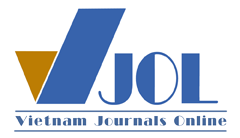Release of Cadmium, Lead and Manganese from Unglazed Ceramic Food Containers to Pickled Mustard Greens Juice and Soy Sauce
DOI:
https://doi.org/10.51316/jca.2021.060Keywords:
lead, food, ceramic containers, manganeseAbstract
Leaching of toxic elements from containers to food can be a direct threat to human health, especially when they are used to hold highly corrosive foods over a long time. The concern of this study is the leaching of cadmium, lead and manganese from unglazed ceramic containers when holding two leachates, including pickled mustard greens juice and a soy sauce. The containers were randomly collected from four ceramic production facilities in Bat Trang - Hanoi, Nam Sach - Hai Duong, Tien Hai - Thai Binh and Thuan An - Binh Duong, where no standard was employed to control heavy metal contents in raw materials and products. The release of cadmium, lead and manganese from the containers to the leachates were analyzed at 24-hour intervals for six days for pickle juice and at two-month intervals for a year for soy sauce. The results showed that the concentrations of those elements increased non-linearly during the course of the study and increased more rapidly in the more acidic medium. The concentrations of cadmium, lead and manganese in the pickle juice (pH reduced from 4.1 to 2.9) after six days were 80.78, 140.10, and 150.11 ppb, and in the soy sauce (pH stable at 6.1) after twelve months were 11.32, 11.86 and 13.87 ppb, respectively. It suggests that further research on the long-term leaching of toxic elements from containers to highly acidic foods is needed to protect the health of consumers.
Downloads
References
Chang, L.W., L. Magos, and T. Suzuki, Toxicology of metals. 1996: Taylor & Francis US.
Abou-Arab, A. and M. Abou Donia, Heavy metals in Egyptian spices and medicinal plants and the effect of processing on their levels. Journal of agricultural and food chemistry, 2000. 48(6): p. 2300-2304. https://doi.org/10.1021/jf990508p
Schütz, A., et al., Lead in finger bone, whole blood, plasma and urine in lead-smelter workers: extended exposure range. International archives of occupational and environmental health, 2005. 78(1): p. 35-43. https://doi.org/10.1007/s00420-004-0559-5
Lepper, T.W., et al., Lead inhibits in vitro creatine kinase and pyruvate kinase activity in brain cortex of rats. Toxicology In Vitro, 2010. 24(3): p. 1045-1051. https://doi.org/10.1016/j.tiv.2009.11.012
Buchko, G.W., N.J. Hess, and M.A. Kennedy, Cadmium mutagenicity and human nucleotide excision repair protein XPA: CD, EXAFS and 1H/15N-NMR spectroscopic studies on the zinc (II)-and cadmium (II)-associated minimal DNA-binding domain (M98–F219). Carcinogenesis, 2000. 21(5): p. 1051-1057. https://doi.org/10.1093/carcin/21.5.1051
Keen, C.L., J.L. Ensunsa, and M.S. Clegg, Manganese metabolism in animals and humans including the toxicity of manganese. Met Ions Biol Syst, 2000. 37(2): p. 89-121.
Gulson, B.L., et al., Non-orebody sources are significant contributors to blood lead of some children with low to moderate lead exposure in a major lead mining community. Science of the total environment, 1996. 181(3): p. 223-230. https://doi.org/10.1016/0048-9697(95)05015-9
Wallace, D., D. Kalman, and T. Bird, Hazardous lead release from glazed dinnerware: A cautionary note. Science of the total environment, 1985. 44(3): p. 289-292. https://doi.org/10.1016/0048-9697(85)90101-9
Seldén, A.I., B.E. Bergström, and L.-G. Gunnarsson, Lead exposure from tourist earthenware: a pilot survey. International journal of hygiene and environmental health, 2008. 211(5-6): p. 587-590. https://doi.org/10.1016/j.ijheh.2007.11.003











